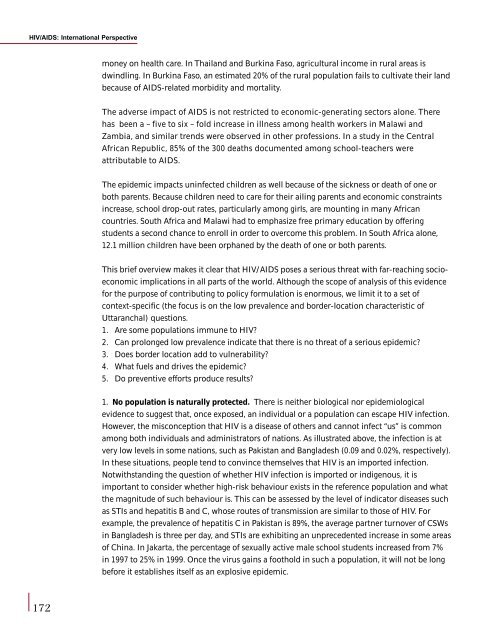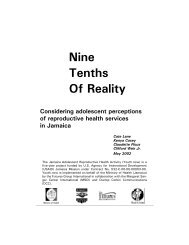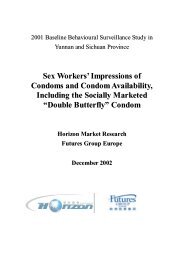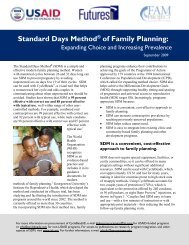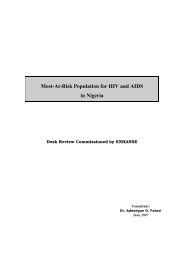Health Policy Issues and Health Programmes in ... - Amazon S3
Health Policy Issues and Health Programmes in ... - Amazon S3
Health Policy Issues and Health Programmes in ... - Amazon S3
- No tags were found...
You also want an ePaper? Increase the reach of your titles
YUMPU automatically turns print PDFs into web optimized ePapers that Google loves.
HIV/AIDS: International Perspectivemoney on health care. In Thail<strong>and</strong> <strong>and</strong> Burk<strong>in</strong>a Faso, agricultural <strong>in</strong>come <strong>in</strong> rural areas isdw<strong>in</strong>dl<strong>in</strong>g. In Burk<strong>in</strong>a Faso, an estimated 20% of the rural population fails to cultivate their l<strong>and</strong>because of AIDS-related morbidity <strong>and</strong> mortality.The adverse impact of AIDS is not restricted to economic-generat<strong>in</strong>g sectors alone. Therehas been a – five to six – fold <strong>in</strong>crease <strong>in</strong> illness among health workers <strong>in</strong> Malawi <strong>and</strong>Zambia, <strong>and</strong> similar trends were observed <strong>in</strong> other professions. In a study <strong>in</strong> the CentralAfrican Republic, 85% of the 300 deaths documented among school-teachers wereattributable to AIDS.The epidemic impacts un<strong>in</strong>fected children as well because of the sickness or death of one orboth parents. Because children need to care for their ail<strong>in</strong>g parents <strong>and</strong> economic constra<strong>in</strong>ts<strong>in</strong>crease, school drop-out rates, particularly among girls, are mount<strong>in</strong>g <strong>in</strong> many Africancountries. South Africa <strong>and</strong> Malawi had to emphasize free primary education by offer<strong>in</strong>gstudents a second chance to enroll <strong>in</strong> order to overcome this problem. In South Africa alone,12.1 million children have been orphaned by the death of one or both parents.This brief overview makes it clear that HIV/AIDS poses a serious threat with far-reach<strong>in</strong>g socioeconomicimplications <strong>in</strong> all parts of the world. Although the scope of analysis of this evidencefor the purpose of contribut<strong>in</strong>g to policy formulation is enormous, we limit it to a set ofcontext-specific (the focus is on the low prevalence <strong>and</strong> border-location characteristic ofUttaranchal) questions.1. Are some populations immune to HIV?2. Can prolonged low prevalence <strong>in</strong>dicate that there is no threat of a serious epidemic?3. Does border location add to vulnerability?4. What fuels <strong>and</strong> drives the epidemic?5. Do preventive efforts produce results?1. No population is naturally protected. There is neither biological nor epidemiologicalevidence to suggest that, once exposed, an <strong>in</strong>dividual or a population can escape HIV <strong>in</strong>fection.However, the misconception that HIV is a disease of others <strong>and</strong> cannot <strong>in</strong>fect “us” is commonamong both <strong>in</strong>dividuals <strong>and</strong> adm<strong>in</strong>istrators of nations. As illustrated above, the <strong>in</strong>fection is atvery low levels <strong>in</strong> some nations, such as Pakistan <strong>and</strong> Bangladesh (0.09 <strong>and</strong> 0.02%, respectively).In these situations, people tend to conv<strong>in</strong>ce themselves that HIV is an imported <strong>in</strong>fection.Notwithst<strong>and</strong><strong>in</strong>g the question of whether HIV <strong>in</strong>fection is imported or <strong>in</strong>digenous, it isimportant to consider whether high-risk behaviour exists <strong>in</strong> the reference population <strong>and</strong> whatthe magnitude of such behaviour is. This can be assessed by the level of <strong>in</strong>dicator diseases suchas STIs <strong>and</strong> hepatitis B <strong>and</strong> C, whose routes of transmission are similar to those of HIV. Forexample, the prevalence of hepatitis C <strong>in</strong> Pakistan is 89%, the average partner turnover of CSWs<strong>in</strong> Bangladesh is three per day, <strong>and</strong> STIs are exhibit<strong>in</strong>g an unprecedented <strong>in</strong>crease <strong>in</strong> some areasof Ch<strong>in</strong>a. In Jakarta, the percentage of sexually active male school students <strong>in</strong>creased from 7%<strong>in</strong> 1997 to 25% <strong>in</strong> 1999. Once the virus ga<strong>in</strong>s a foothold <strong>in</strong> such a population, it will not be longbefore it establishes itself as an explosive epidemic.172


